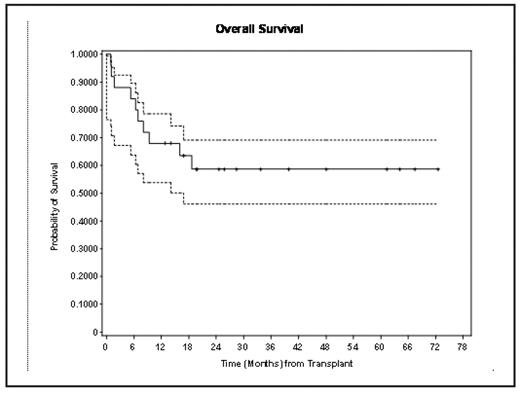Abstract
Acute lymphoblastic leukemia has a poor prognosis in adults, with a two-year survival rate of 35–40% despite aggressive therapy (American Cancer Society: Cancer Facts and Figures 2008 Atlanta, GA: American Cancer Society, 2008). Reduced-intensity allogeneic stem cell transplantation (SCT) relies mainly on graft versus leukemia (GVL) for its efficacy; however, the role of GVL in ALL is less well-defined. Between 5/7/02 and 6/15/07, 25 adult ALL patients were uniformly treated with fludarabine 25mg/m2 daily for 5 days and melphalan 140mg/m2 followed by ALLO-SCT using peripheral blood stem cells. The indications for the reduced intensity regimen were:
≥ 50 years (10 pts) (40%),
decreased organ function (9 pts) (36%) and
previous ALLO-SCT (6 pts) (24%).
Patient demographics include: median age, 47 years (range, 23–68 yrs.), remission status at ALLO-SCT: first complete remission (CR) (12 pts) (48%), first relapse (3 pts) (12%), second CR (5 pts) (20%), >second CR (4 pts) (16%), induction failure (one pt) (4%), t(9;22) or Philadelphia positive (Ph+) ALL(9 pts) (36%). Donor source was matched sibling in 9 pts (36%), and matched unrelated in 16 pts (64%). Graft versus host disease (GVHD) prophylaxis: was cyclosporine (CSA)/+ mycophenylate (MMF) (3 pts) (12%), CSA/MMF/methotrexate (MTX) (8 pts) (32%), CSA/MMF/ATG (one pt) (4%), tacrolimus/sirolimus (7 pts) (28%) and tacrolimus/sirolimus/MTX (6 pts) (24%). With a median follow-up for surviving patients of 28.5 months (range: 12.8–72.5 months), the two year cumulative probability of overall survival and disease-free survival were both 59% (95% CI: 46–69.2%). The relapse rate was 16% (95% CI: 6.4,–37.4%),. Incidence of acute GVHD was 60% for grade II–IV and 20% for grade III–IV. Of the patients at risk for chronic GVHD, 8% developed limited chronic GVHD and 60% developed extensive chronic GVHD. The 100-day, one year and two year non-relapse mortality rates were 12% (CI: 4.6–29.3%), 24.2% (CI: 14–39.9%) and 29.3% (CI: 18.4–44.6%), respectively. There was no difference in survival outcomes based on donor source. The results of this study show that reduced intensity ALLO-SCT using fludarabine/melphalan based conditioning with primed peripheral stem cells from a matched related or unrelated donor provides a curative option for patients with high risk ALL who are not eligible for full intensity transplant.
Disclosures: No relevant conflicts of interest to declare.
Author notes
Corresponding author


This feature is available to Subscribers Only
Sign In or Create an Account Close Modal